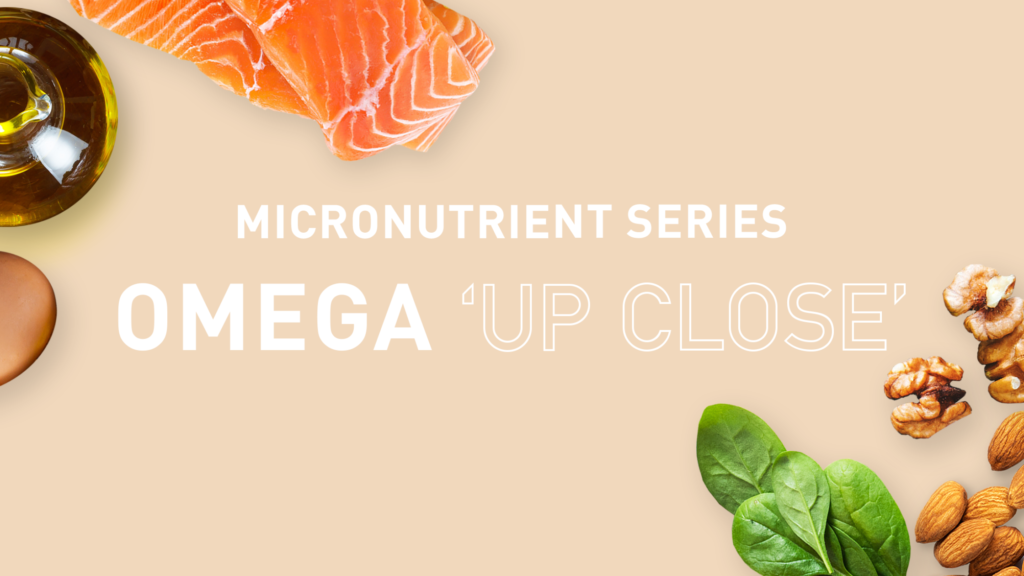Omega ‘Up Close’

What is omega-3 and omega-6 and what’s the difference?
Both omega-3 and omega-6 are healthy polyunsaturated fatty acids (PUFAs). Their name refers to their chemical structures. Polyunsaturated fats have two or more double bonds. In omega-3 fatty acids, the first double bond occurs on the third carbon atom, but in omega-6 fatty acids, the first double bond is on the sixth carbon atom.
Omega-3 plays a vital role in the formation of cell membranes. Omega-3 and omega-6 are also used to form eicosanoids. Eicosanoids are signalling molecules that play a role in inflammatory responses and blood pressure regulation. There is increasing support that omega-3s may play a role in the prevention of heart disease, diabetes and cancer, however, excessive amounts of omega-6 may promote the pathogenesis of these diseases. There’s no need to avoid omega-6s in your diet, as long as they’re consumed in moderation, they may also be beneficial for our cholesterol levels.
“Most of us would benefit from eating more foods containing ALA, EPA and DHA”
There are three types of omega-3 fats:
-
- ALA (alpha linoleic acid)
- DHA (Docosahexanoic acid)
- EPA (Eicosapentaenoic acid)
There are four types of omega-6 fats:
-
- LA (Linoleic acid)
- ARA (Arachidonic Acid)
- GLA (Gamma linoleic)
- CLA (Conjugated linoleic acid)
The human body is capable of producing all the fatty acids it needs, except for ALA and LA. These are both “essential fatty acids” as they need to be obtained from the diet. Your body can convert some ALA into EPA and then to DHA, but only in very small amounts. For this reason, it’s recommended to incorporate foods rich in these fats into your diet.
What is the recommended daily intake of omega-3/omega-6?
Our Western diet provides us with plenty of omega-6s and most of us would benefit from eating more foods containing ALA, EPA and DHA.
“The easiest way to increase omega-3 fats in your diet is by including at least two portions of fish a week, including one of fatty fish”
The European Food Safety Authority has set the adequate intake for:
- EPA and DHA: 250mg a day
- ALA: 0.5% of your kcal intake
There’s not an adequate intake or an upper limit for the intake of omega-6s.
Which foods contain omega-3/omega-6?
Many plant-based cooking oils contain omega-3 and omega-6, so it’s good to alternate between different oils.
Foods rich in omega-3 fats:
-
- Fatty fish (Salmon, Mackerel, Anchovies, Sardines, Trout, Herring, Tuna)
- Shellfish
- Flaxseeds and flaxseed oil
- Chia seeds
- Walnuts and walnut oil
- Soybeans and soy products like tofu and tempeh
- Avocado
- Canola oil
- Seaweed
- Fortified products (certain brands of eggs, juice, yoghurt, milk)
Foods rich in omega-6 fats:
-
- Flaxseeds and flaxseed oil
- Hemp seeds and hemp seed oil
- Sunflower seeds and sunflower oil
- Grapeseed oil
- Walnuts and walnut oil
- Pumpkin seeds
- Pine nuts
- Pistachios
How can I increase the omega-3 levels in my diet?
The easiest way to increase omega-3 fats in your diet is by including at least two portions of fish a week, including one of fatty fish. Eating fish is good for you in other ways too; They’re a good source of vitamin D, the B vitamins and other minerals like zinc, iron, calcium and selenium.
For those who don’t eat fish, we’ve put together some tips to increase your levels with other foods:
- Mix flax seeds and/or chia seeds with your yoghurt, cereal or porridge
- Drizzle flaxseed oil, walnut oil or canola oil as a dressing over your salads
- If you like baking, you can add flax seeds to your bread, muffins, cookies or other baked goods
- Sprinkle walnuts over your salad, or add them to a stir-fry.
- Add avocado to your salad, toast/sandwich or egg-based breakfasts
- Include tofu (or another soy product) on your menu once a week. Try it as a breakfast scramble, crisp it up for your lunch or as a snack, or add it to stews or curries
It’s always best to get your nutrients from foods rather than supplements. That’s because foods contain a whole range of different nutrients which improve your health in different ways and supplements only contain specific nutrients. If you feel that your diet lacks foods containing omega-3s, you can also opt to take a supplement. If you choose to top up on omega-3, go for a supplement with lower levels of vitamin A (less than 1 mg) and avoid fish liver oils.
Fresh Fitness Food provides personalised meals plans delivered straight to your door, ensuring not only that you have the nutrients you need to manage your stress levels, but also that you have the time usually spent shopping, cooking and washing up, to engage in your favourite stress reducing activity. To discuss which nutrition plan is right for you, book a call with our in-house nutrition team here.
Order today and start smashing your goals with personalised nutrition!
Get £50 off a 5-day trial with code: BLOG50